Land of the Eternal Blue Sky

Mongolia is vast and sparsely populated.
Unspoiled and undisturbed, Mongolia is an unending countryside of rolling steppes and fenceless grasslands. It is perhaps best known as the home of Genghis Khan and the nucleus of his powerful empire, which stretched from the Pacific Ocean to the heart of Europe.
The Mongolia I visited recently is much smaller than that once-feared empire. Landlocked and serene, it is inhabited today by famously hospitable and good-natured people, but only sparsely: It is the least densely populated independent country on earth. Exuding an end-of-the-earth allure, it is not easy or inexpensive to get to, yet it remains on the bucket list of veteran travelers—it had long been on mine.
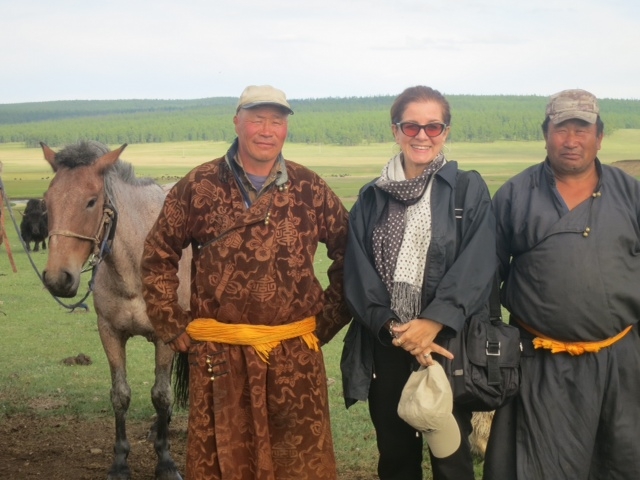
Patricia with local herdsmen.
A country in transition, Mongolia deserves to be seen, and soon. The discovery of a treasure trove of natural resources including copper, gold, and coal is drawing once-nomadic families to the big city in droves with the promise of work opportunities and running water. The entire country, nearly the size of Western Europe, has a population closer to that of Chicago (around 3 million). About half of them are now living in or near Ulan Bator, the sprawling capital city of snarled traffic, construction cranes, and sleek Armani stores.
Although “UB” has its own curious charm, no one comes to Mongolia to linger there. The magnificent countryside we had come to see was just a drive away: One overnight stay was spent at the idyllic Gun-Galuut Nature Reserve, where the wide-open steppes merge with wetlands some 2.5 hours by car trip from UB. There are precious few roads in this ancient land, where a horseback riding culture persists. The occasional two-lane highways we traveled were recently paved, but passing cars were infrequent. We sped along, past empty grasslands while listening to the otherworldly music of the country’s famous throat singers (it’s hypnotic), transfixed by the terse blue sky and its ever-changing configurations of white clouds. Although tourism has doubled in the last decade, numbers are limited and foreign visitors still feel like they have the peaceful, mostly Buddhist country to themselves.
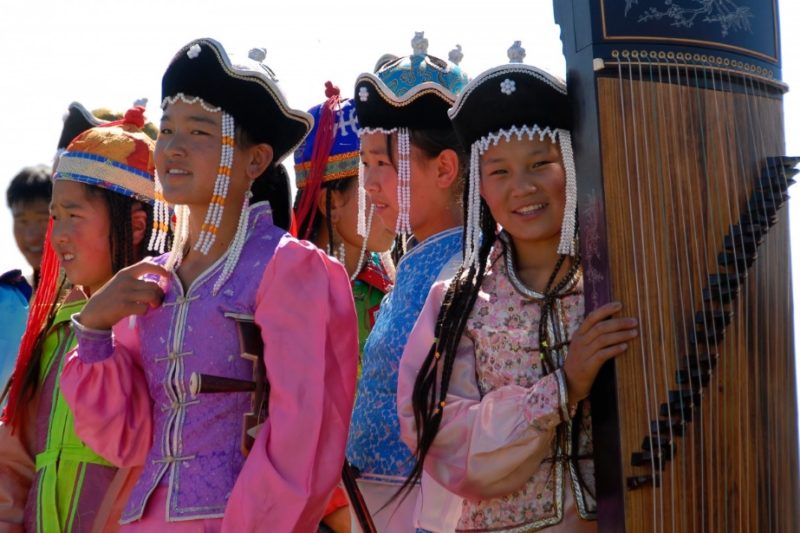
Young girls dressed in traditional costume for the Naadam Festival.
Mongolia celebrates its independence on and around July 11 every year with the much-anticipated Naadam Festival, centered on the manly games of wrestling, horse racing, and archery. These age-old games are often associated with warrior training in the time of Genghis Khan, but their origins can be traced back far before that. Experiencing the games was the highlight of the trip organized by Nomadic Expeditions, a US-based trailblazer in tourism to Mongolia. The televised national games take place in UB among growing crowds (and tourists), but Nomadic Expeditions knowingly arranged for our small group to enjoy the festivities in a small city off in the distant Gobi desert, by far a more intimate and genuine experience.
The Gobi occupies the southern third of the country, a fascinating and varied region with one of the most diverse ecosystems on earth. One day we trekked through the surprisingly green Yol Valley, and the next clung to the shaggy double humps of our Bactrian camels, lumbering through a sweeping desert of golden dunes. Jeeps carried us to the red sandstone Flaming Cliffs, famous as the site of the 1923 discovery of the world’s first nest of fossilized dinosaur eggs. At the end of an exhilarating hike, a sunset dinner under the backdrop of the desert’s stunning natural beauty awaited us.
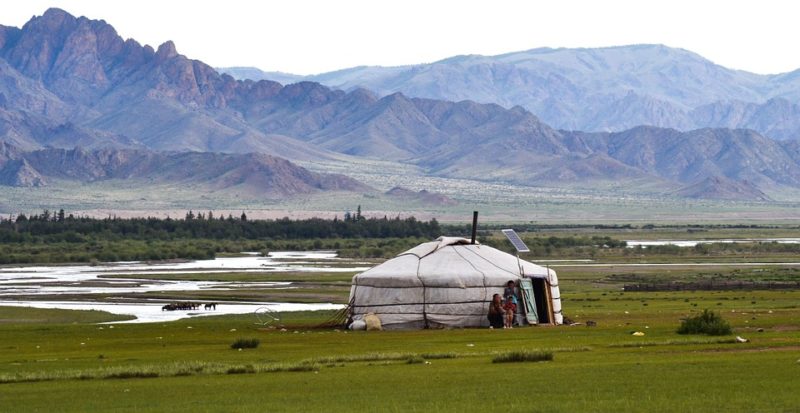
This family’s ger (yurt) is located miles from its closest neighbor.
The Three Camel Lodge is the finest place to stay in the Gobi. Not quite glamping, it was our oasis-in-the-middle-of-nowhere home. Created and professionally managed by Nomadic Expeditions with a gracious can-do Mongolian staff, it was the nicest of the trip’s selection of rustic ger camps—the circular shaped “ger” is the traditional white felt-lined tent of the nomadic herder, known elsewhere by its Turkish name, “yurt.” More rudimentary gers served as our perfectly-situated accommodation on the shore of Lake Hovsgol. The country’s deepest and second-largest lake and primary freshwater resource is a highlight of Mongolia’s northernmost region on the border with Russia’s Siberia, and shares a similar ecosystem and natural beauty with nearby Lake Baikal. Days were spent hiking through larch and pine forests to visit the legendary Tsaatan reindeer herders, or horseback riding for the more daring among us. We dropped in to visit local herders (their ger had a satellite dish out front, a common sight), and motorboated the incredibly crystal-clear waters. We did our best at deconstructing a ger (with a lot of help) to understand its simple practicality as a traveling home for a nomadic family. Our Mongolian friends laughed at our city-slicker haplessness, visibly proud that we had come so far to experience their remarkable Land of Eternal Blue Sky.
Nomadic Expeditions, with offices in the US and Ulan Bator:
Tel 800-998-6634, info@nomadicexpeditions.com
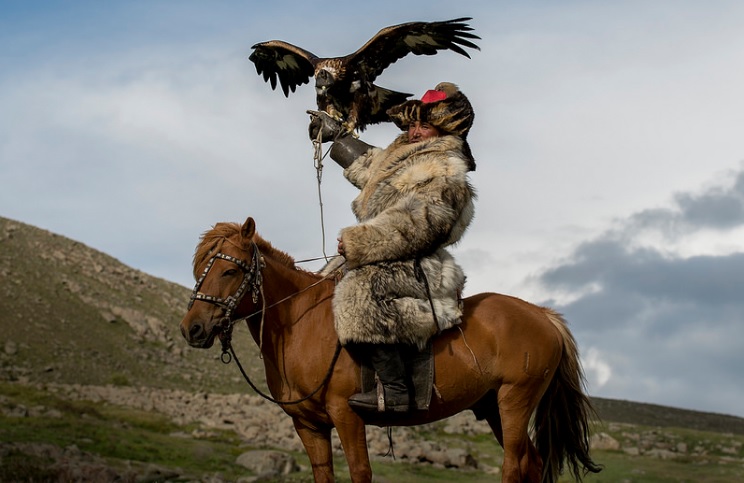
An annual festival celebrates the tradition of horseback hunting with golden eagles.
And don’t forget to check out the book!
 About the Book:
About the Book:
The world’s bestselling travel book is back in a more informative, more experiential, more budget-friendly full-color edition. A #1 New York Times bestseller, 1,000 Places reinvented the idea of travel book as both wish list and practical guide. As Newsweek wrote, it “tells you what’s beautiful, what’s fun, and what’s just unforgettable—everywhere on earth.” And now the best is better. There are 600 full-color photographs. Over 200 entirely new entries, including visits to 28 countries like Lebanon, Croatia, Estonia, and Nicaragua, that were not in the original edition. There is an emphasis on experiences: an entry covers not just Positano or Ravello, but the full 30-mile stretch along the Amalfi Coast.
Every entry from the original edition has been readdressed, rewritten, and made fuller, with more suggestions for places to stay, restaurants to visit, and festivals to check out. And throughout, the book is more budget-conscious, with starred restaurants and historic hotels such as the Ritz, but also moderately priced gems that don’t compromise on atmosphere or charm.
The world is calling. Time to answer.
Buy the Book
Amazon | B&N | Indiebound | Workman

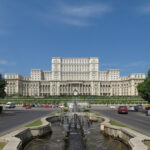
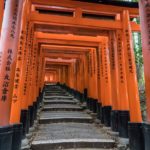
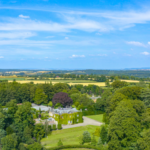
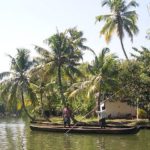
No Comments